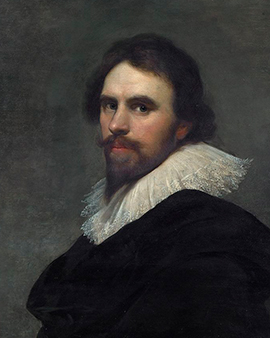Daniël Mijtens (1590 - 1647) is originally from the Netherlands, as his name suggests. In the course of his life, he moved to England, where he became known as the great painter Daniel Mytens the Elder. As the scion of a Flemish family of artists, his talent was certainly also in his cradle. It was obvious that he himself also started a career as an artist. Mytens studied in The Hague with the very successful Dutch portrait painter Michiel van Mierevelt. He was also known for his works with historical and mythological scenes. In 1618 he went to London. There he worked for the well-known leading art and antique collector Sir Thomas Howard, the 21st Earl of Arundel. The British nobleman held important offices at court. Among other things, he carried out diplomatic missions for the royal house. With the contact to Sir Thomas Howard, Daniel Mytens expanded his network in London by an influential and important person and laid an important foundation for his later career as an artist. Almost two years later, success was evident: Daniel Mytens received his first commission from the British royal house. Later he worked as court painter and royal portraitist. The Prince of Wales was enthusiastic about his works, which is why he supported him during his naturalization in 1624.
A look at Myten's work shows that he was significantly influenced by Rubens artwork. During his time as a court painter, he painted portraits of the British nobility. Working for the royal house was attractive and offered many freedoms. The status of the court artists was considered privileged. Finally, musicians, artists and architects fulfilled important representative functions of the royal house. In today's specialist literature, court artists are regarded as an early form of modern, autonomous artists. In 1625 Daniel Mytens set off on a journey to his homeland at the behest of Charles I. He used the time there to study the artistic trends and developments. In 1632 his activity as court painter came to an end. His successor was the Dutch artist Anthonis van Dyck. It is understandable that Mytens was disappointed with this decision. Van Dyck used the opportunity to demonstrate his superiority. One of his works was based on Mytens' original, but he used a better technical implementation.
After a very successful time in England, the former court painter returned to his home country. In the Netherlands he worked as an art dealer and bought works of art on behalf of the Earl of Arundel. In 1647 he died in The Hague. Today none of his early works from his time in the Netherlands have been preserved. Only the works from his creative period in England can still be admired today. Myten's legacy is to have established a new naturalism in English court painting. Some of his works of art are still in the possession of the British royal family today.
×





.jpg)
.jpg)
.jpg)
.jpg)
.jpg)
.jpg)
_2nd_Marquis_of_Hamilton_from_Lodges_Briti_-_(MeisterDrucke-120856).jpg)
_2nd_Marquis_of_Hamilton_from_Lodges_Briti_-_(MeisterDrucke-120856).jpg)
 - (MeisterDrucke-243612).jpg)
 - (MeisterDrucke-243612).jpg)
.jpg)
.jpg)
.jpg)
.jpg)
.jpg)
.jpg)
.jpg)
.jpg)
.jpg)
.jpg)
.jpg)
.jpg)
.jpg)
.jpg)
.jpg)
.jpg)
.jpg)
.jpg)
.jpg)
.jpg)
.jpg)
.jpg)
.jpg)
.jpg)
 - (MeisterDrucke-138518).jpg)
 - (MeisterDrucke-138518).jpg)
.jpg)
.jpg)
_-_(MeisterDrucke-320802).jpg)
_-_(MeisterDrucke-320802).jpg)
.jpg)
.jpg)
.jpg)
.jpg)
_-_(MeisterDrucke-1092431).jpg)
_-_(MeisterDrucke-1092431).jpg)
.jpg)
.jpg)
 (panel) - (MeisterDrucke-184222).jpg)
 (panel) - (MeisterDrucke-184222).jpg)
_1785-1786_-_(MeisterDrucke-644257).jpg)
_1785-1786_-_(MeisterDrucke-644257).jpg)
.jpg)
.jpg)
.jpg)
.jpg)
.jpg)
.jpg)
.jpg)
.jpg)
.jpg)
.jpg)
.jpg)
.jpg)
.jpg)
.jpg)
.jpg)
.jpg)
.jpg)
.jpg)
.jpg)
.jpg)
.jpg)
.jpg)
.jpg)
.jpg)
_c_1770_(pastel_on_paper_-_(MeisterDrucke-644255).jpg)
_c_1770_(pastel_on_paper_-_(MeisterDrucke-644255).jpg)
.jpg)
.jpg)
 - (MeisterDrucke-158150).jpg)
 - (MeisterDrucke-158150).jpg)
.jpg)
.jpg)
.jpg)
.jpg)
.jpg)
.jpg)
.jpg)
.jpg)
.jpg)
.jpg)
_-_(MeisterDrucke-1457890).jpg)
_-_(MeisterDrucke-1457890).jpg)
_-_(MeisterDrucke-1461666).jpg)
_-_(MeisterDrucke-1461666).jpg)
.jpg)
.jpg)
.jpg)
.jpg)
 - (MeisterDrucke-179571).jpg)
 - (MeisterDrucke-179571).jpg)
_c1631_(oil_on_canvas)_-_(MeisterDrucke-1501189).jpg)
_c1631_(oil_on_canvas)_-_(MeisterDrucke-1501189).jpg)
.jpg)
.jpg)
.jpg)
.jpg)




